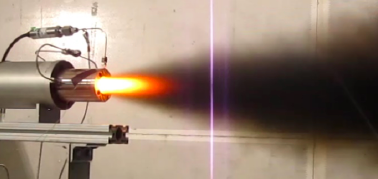Thrust Augmentation of an Additively Manufactured Hybrid Rocket System Using Secondary H2O2 Injection
A thrust augmentation system for hybrid rocket engines, in which a secondary, tunable injection of oxidizer in the nozzle provides increased and adjustable thrust.
Problem
Rocket engines with high-expansion-ratio nozzles are inefficient and unstable at low altitudes, including at launch. This problem can be addressed by a secondary burn of propellants injected directly into the nozzle to compensate for altitude effects. Previous embodiments of secondary injection technology include injection of both fuel and oxidizer, which complicates system design.
Solution
The technology includes combustion of specially-printed solid ABS fuel grains such that some fuel in the exhaust plume is left unburned. When the fuel-rich plume is exposed to oxidizer, secondary combustion occurs. Secondary injection in the nozzle includes only oxidizer, rather than both oxidizer and fuel.
Benefits
Secondary injection of only one propellant instead of two significantly simplifies the complexity of implementing a secondary burn in the nozzle. The storage, piping, and control mechanisms required for secondary injection are for only one fluid instead of two. Moreover, a hybrid rocket using this technology needs only two propellant types: one solid fuel and one fluid oxidizer. Previously, hybrid rockets with dual-injection propellants in the nozzle required a fluid fuel for injection, in addition to the solid fuel that might be used in the main combustion chamber.
Applications
The technology could be implemented in any future hybrid rockets to save significant costs associated with design and manufacturing with secondary injection in mind. Of special interest are rockets purposed with delivering small satellites into space. The use of small satellites is increasing, and rockets equipped with this technology potentially present significant cost and weight advantages over other hybrid rockets for satellite delivery.

Contact
Questions about this technology including licensing availability can be directed to:
Alan Edwards, MA, JD
Manager, Technology Transfer Services
(435) 797-2328 alan.edwards@usu.edu
USU ID C20023
Inventors
Stephen Whitmore, Ph.D.
Mechanical and Aerospace Engineering
Mark Heiner, M.S.
Mechanical and Aerospace Engineering
Development Stage
TRL 4

